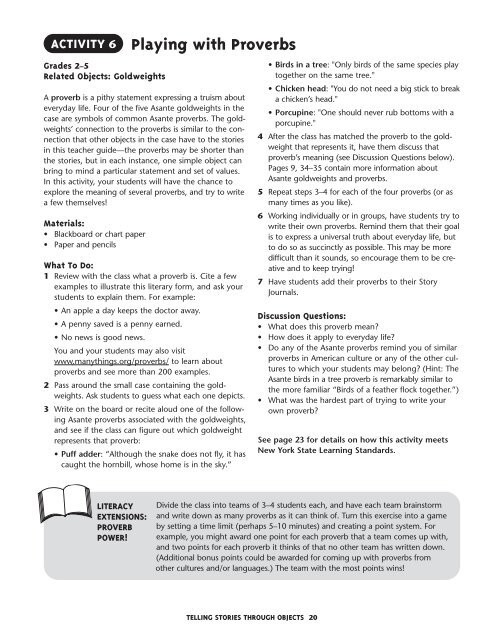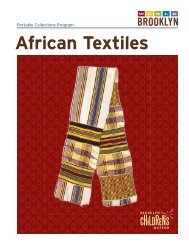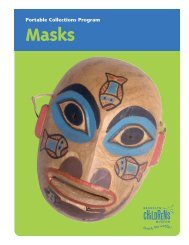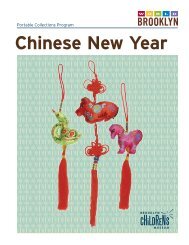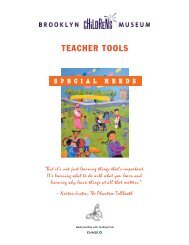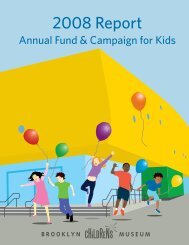Telling Stories Through Objects - Brooklyn Children's Museum
Telling Stories Through Objects - Brooklyn Children's Museum
Telling Stories Through Objects - Brooklyn Children's Museum
Create successful ePaper yourself
Turn your PDF publications into a flip-book with our unique Google optimized e-Paper software.
ACTIVITY 6<br />
Grades 2–5<br />
Related <strong>Objects</strong>: Goldweights<br />
Playing with Proverbs<br />
A proverb is a pithy statement expressing a truism about<br />
everyday life. Four of the five Asante goldweights in the<br />
case are symbols of common Asante proverbs. The goldweights’<br />
connection to the proverbs is similar to the connection<br />
that other objects in the case have to the stories<br />
in this teacher guide—the proverbs may be shorter than<br />
the stories, but in each instance, one simple object can<br />
bring to mind a particular statement and set of values.<br />
In this activity, your students will have the chance to<br />
explore the meaning of several proverbs, and try to write<br />
a few themselves!<br />
Materials:<br />
• Blackboard or chart paper<br />
• Paper and pencils<br />
What To Do:<br />
1 Review with the class what a proverb is. Cite a few<br />
examples to illustrate this literary form, and ask your<br />
students to explain them. For example:<br />
• An apple a day keeps the doctor away.<br />
• A penny saved is a penny earned.<br />
• No news is good news.<br />
You and your students may also visit<br />
www.manythings.org/proverbs/ to learn about<br />
proverbs and see more than 200 examples.<br />
2 Pass around the small case containing the goldweights.<br />
Ask students to guess what each one depicts.<br />
3 Write on the board or recite aloud one of the following<br />
Asante proverbs associated with the goldweights,<br />
and see if the class can figure out which goldweight<br />
represents that proverb:<br />
• Puff adder: “Although the snake does not fly, it has<br />
caught the hornbill, whose home is in the sky.”<br />
LITERACY<br />
EXTENSIONS:<br />
PROVERB<br />
POWER!<br />
TELLING STORIES THROUGH OBJECTS 20<br />
• Birds in a tree: "Only birds of the same species play<br />
together on the same tree."<br />
• Chicken head: "You do not need a big stick to break<br />
a chicken’s head."<br />
• Porcupine: "One should never rub bottoms with a<br />
porcupine."<br />
4 After the class has matched the proverb to the goldweight<br />
that represents it, have them discuss that<br />
proverb’s meaning (see Discussion Questions below).<br />
Pages 9, 34–35 contain more information about<br />
Asante goldweights and proverbs.<br />
5 Repeat steps 3–4 for each of the four proverbs (or as<br />
many times as you like).<br />
6 Working individually or in groups, have students try to<br />
write their own proverbs. Remind them that their goal<br />
is to express a universal truth about everyday life, but<br />
to do so as succinctly as possible. This may be more<br />
difficult than it sounds, so encourage them to be creative<br />
and to keep trying!<br />
7 Have students add their proverbs to their Story<br />
Journals.<br />
Discussion Questions:<br />
• What does this proverb mean?<br />
• How does it apply to everyday life?<br />
• Do any of the Asante proverbs remind you of similar<br />
proverbs in American culture or any of the other cultures<br />
to which your students may belong? (Hint: The<br />
Asante birds in a tree proverb is remarkably similar to<br />
the more familiar “Birds of a feather flock together.”)<br />
• What was the hardest part of trying to write your<br />
own proverb?<br />
See page 23 for details on how this activity meets<br />
New York State Learning Standards.<br />
Divide the class into teams of 3–4 students each, and have each team brainstorm<br />
and write down as many proverbs as it can think of. Turn this exercise into a game<br />
by setting a time limit (perhaps 5–10 minutes) and creating a point system. For<br />
example, you might award one point for each proverb that a team comes up with,<br />
and two points for each proverb it thinks of that no other team has written down.<br />
(Additional bonus points could be awarded for coming up with proverbs from<br />
other cultures and/or languages.) The team with the most points wins!


